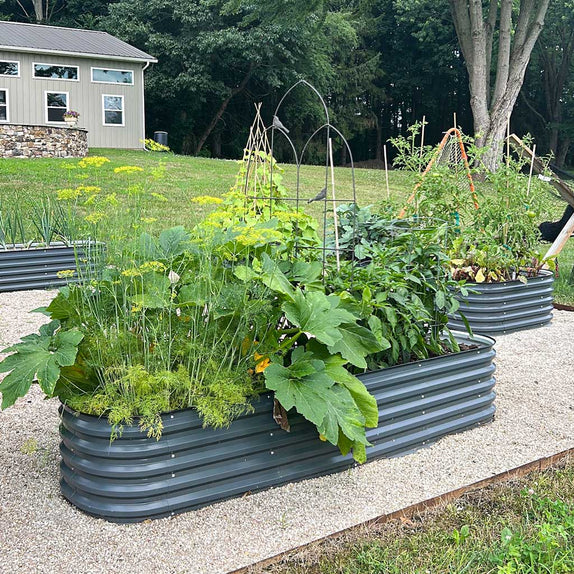When the cold season comes, gardens need special care. Winterizing garden beds means getting them ready for winter. This helps plants stay safe and soil stay healthy. If you want your garden to grow well next spring, winterizing is important.
Why Winterize Garden Beds?
Winter can be hard on plants and soil. Cold weather, frost, and snow can harm them. Winterizing:
- Keeps soil from washing away.
- Protects plant roots from freezing.
- Stops weeds from growing.
- Helps soil stay rich for new plants.
If you skip winterizing, your garden may not grow well next year. Soil can lose nutrients. Plants may die or get weak.

Credit: www.gardeningknowhow.com
When to Start Winterizing Garden Beds?
It is best to start before the first hard frost. This time is different in each place. Watch the weather forecast. Usually, start when nights get very cold. This gives you time to prepare.
Steps to Winterize Your Garden Beds
1. Clear The Garden Bed
Remove old plants and weeds. Dead plants can carry pests and diseases. Clear leaves and debris too. This helps keep pests away. Use gloves and garden tools to clean well.
2. Add Compost Or Organic Matter
After cleaning, add compost to the soil. Compost adds nutrients and keeps soil healthy. Spread a layer about 2 to 3 inches thick. Mix it gently into the topsoil with a garden fork or rake.
3. Mulch The Bed
Mulch is material like straw, leaves, or wood chips. It covers the soil and protects it. Mulch stops soil from freezing and drying out. Spread mulch 3 to 4 inches thick over the bed. Keep mulch away from plant stems to avoid rot.
4. Protect Plants
If you have plants that stay in winter, protect them. Use burlap, old sheets, or frost cloth. Cover plants during very cold nights. Remove covers in the day to let air and light in.
5. Water Before Winter
Water your garden beds well before the ground freezes. Moist soil holds heat better than dry soil. This helps protect roots from cold damage. But don’t water too much; avoid waterlogging.
6. Plan For Spring
Think about what you want to plant next year. You can add slow-release fertilizer now if needed. This gives food to soil and plants in spring. Write down your plans to help you remember.
Best Materials to Use for Winterizing
Choosing the right materials makes winterizing easier and better.
| Material | Use | Benefits |
|---|---|---|
| Compost | Mix into soil | Adds nutrients, improves soil |
| Straw | Mulch cover | Keeps soil warm, stops weeds |
| Leaves | Mulch or compost | Protects soil, adds nutrients |
| Wood Chips | Mulch cover | Stops soil erosion, holds moisture |
| Burlap | Plant cover | Protects plants from frost |
| Frost Cloth | Plant cover | Allows air and light, protects cold |
Tips for a Successful Winterizing
- Remove weeds early to stop seeds spreading.
- Do not pile mulch too close to plant stems.
- Water deeply but do not flood the garden bed.
- Check weather reports to protect plants on cold nights.
- Use natural materials to help soil health.
- Keep garden tools clean to avoid spreading diseases.
Common Mistakes to Avoid
Some mistakes can hurt your garden during winter. Avoid these:
- Leaving dead plants in beds can spread pests.
- Using too much mulch can cause rot.
- Not watering before freeze can dry roots.
- Ignoring frost protection for sensitive plants.
- Starting too late after frost has begun.

Credit: www.youtube.com
How Winterizing Helps Your Garden Long-Term
Winterizing is not just for cold months. It helps your garden grow better every year.
- Soil stays full of nutrients.
- Plants start strong in spring.
- Weeds are easier to control.
- Garden looks neat and healthy.
When you care for your garden in winter, you get rewards in summer.
Frequently Asked Questions
How Do I Start Winterizing My Garden Beds?
Begin by cleaning up debris. Remove dead plants and weeds. This prevents pests and diseases.
What Materials Are Best For Mulching Garden Beds?
Use straw, leaves, or wood chips. They insulate soil and protect plant roots from freezing.
Should I Prune Plants Before Winter?
Yes, prune dead or diseased branches. This encourages healthy growth in spring.
How Can I Protect My Perennials In Winter?
Cover them with mulch or burlap. This shields them from harsh winter weather.
Conclusion
Winterizing garden beds is simple and important. It protects plants and soil from cold damage. Follow these easy steps:
- Clear old plants and weeds.
- Add compost to enrich soil.
- Spread mulch to protect soil.
- Cover plants if needed.
- Water before the ground freezes.
- Plan for next spring’s garden.
Start early and use natural materials. Your garden will thank you in spring. Healthy soil and strong plants come from good winter care.
Remember, winterizing is a gift to your garden. It helps your plants rest safely and grow well again.
4 min read

